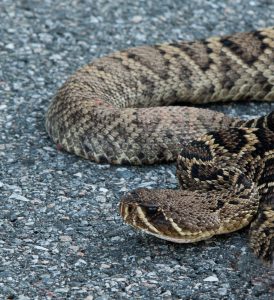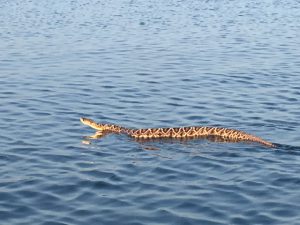This seems like a strange title; of course, they are still around. However, it is referring to the number of encounters beach residents have had this year. The first report was of a large individual coiled beneath a palm tree near a condominium unit by the gate of Ft. Pickens. Park officials relocated this snake. Soon after, another individual was found swimming in the surf within the national seashore. A third was photographed crawling near the gate to Johnson’s Beach on Perdido Key, again within the national seashore. I found a small individual coiled in the hollow space of a live oak tree at Naval Live Oaks in Gulf Breeze, again – within the seashore. And last week I was driving through the Ft. Pickens area and saw one crossing the road near Battery Worth; it safely made it across the road.

Photo: Nick Baldwin
Some would say, “Safely made it across the road? I would not worry about safely making it across the road” – but most of you know I am a fan of snakes and do not wish them ill will. Others feel similar but would rather they stay away from people. I get that. Some would have tried to run over the snake so that it was not a threat to others in the park. I understand that thought process but, as had been said before, snakes are beneficial to the ecosystem, benefitting us by controlling disease-carrying rodents, and rarely approach people – it is usually the other way around. Besides, this is a national park – you cannot run over snakes there.
So what’s up with all the recent encounters?
Is the island overrun with snakes?
This question came up last spring over on Perdido Key when a community was frequently encountering cottonmouths. It would obviously take a population assessment by a qualified herpetologist to determine the density of snakes per acre; but no such study is being conducted – nor are there plans for one anytime soon. They tend to avoid people and, typically, become more visible when they are pushed from their hiding places. They are also more visible during breeding season.
There is concern for safety when discussing the rattlesnake. So let’s learn a little more about this animal. To know them better is to learn how to avoid problems with them.

Photo: Sue Saffron
The Eastern Diamondback Rattlesnake (Crotalus adamanteus) is the largest venomous snake in North America, reaching lengths of eight feet and 4-6 lbs. (though some have weighed as much as 15 lbs.). They prefer high dry ground, such as the dune fields of barrier islands, feed on a variety of rodents, and have a particular fondness for rabbits. Word is, if there are rabbits – there may be rattlesnakes.
When small, they have numerous predators including raptors, mammals, and even bullfrogs. To defend themselves, they lie beneath vegetation cover during the summer months and within burrows and stump holes in the winter. Unlike the cottonmouth, rattlesnakes prefer to hunt during the daylight hours.
They breed in the fall just before the first cold temperatures and then settle into a burrow for the winter. They will have 12-24 young, delivered live, and the females will stay with the young until they shed their first skin, at which the young are on their own.
They tend to avoid human contact and rarely venture into our territory unless (a) we have provided good habitat for their prey, (b) we have reduced their preferred habitat to a point they have no choice. Locally, all recent encounters (less one) have been within the National Seashore. One encounter was in the dune fields near Big Sabine. These are all natural habitats far from people – which is a good thing.
Rattlesnake venom is potent, and people should keep a respectful distance for this animal. My college professor said their venom is “expensive” and meant for killing prey. What he meant by “expensive” was in the energy and compounds to produce it. That said, they would inject venom if their life depends on it. One encounter I read about on a barrier island in Georgia involved a large eastern diamondback. He said the head was close to 4 inches and the coiled body was large enough to cover a manhole. He was not sure how long the snake was, but needless to say – it was a large snake. He was actually a herpetologist who works with snakes and was searching for them. He had a steel snake tong with him. He used that to cover his leg and walked past the snake. The snake never made an attempt to strike convinced it was camouflaged and did not need to. He looked back after a few feet and the rattlesnake remained in the coiled position awaiting a rabbit. Snakes that are annoyed will often rattle and lift into the S-shape strike position. You should give an animal doing this plenty of room, their strike range is 2/3 their body length.
Despite our fears, these are fascinating and beneficial animals. There is a variety of reasons we may be seeing more on our barrier islands, but understanding them will help reduce negative encounters.
References
Gibbons, W. M. Dorcas. 2005. Snakes of the Southeast. University of Georgia Press. Athens GA. pp. 253.
Graham, S. 2018. American Snakes. John Hopkins University Press. Baltimore MD. pp. 293.
 0
0
